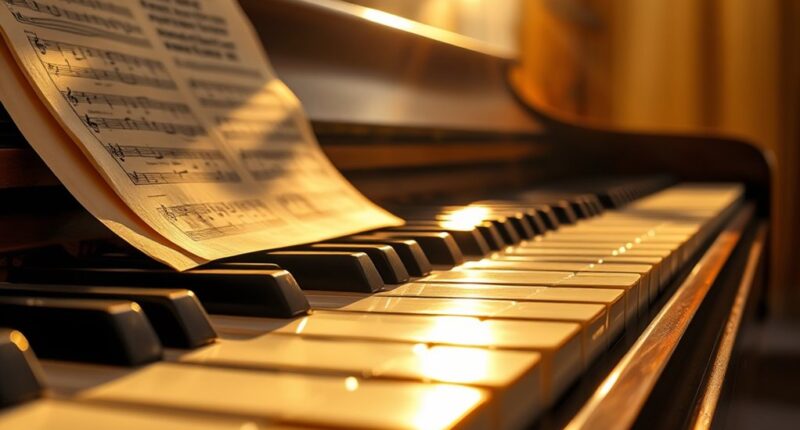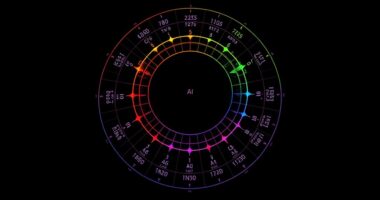Modal interchange makes boring progressions catchier by borrowing chords from parallel modes or keys, adding unexpected colors and emotional shifts. You can swap standard chords with modal counterparts or include borrowed chords like ♭VII or ♭III to create tension, surprise, and deepen emotional expression. These subtle tonal shifts grab the listener’s attention and make melodies more memorable. Keep exploring how these techniques can transform your music and discover even more ways to keep your progressions engaging.
Key Takeaways
- Modal interchange introduces unexpected chords from parallel modes, creating surprise and capturing listener attention.
- Borrowed chords add emotional depth and color, making progressions more expressive and memorable.
- Subtle tonal shifts from modal interchange create a dynamic, engaging mood that keeps listeners interested.
- Replacing standard chords with modal counterparts enhances harmonic variety without overwhelming the progression.
- Using modal interchange sparingly highlights key emotional moments, transforming mundane progressions into ear-catching hooks.
Understanding Modal Interchange: The Basics

Have you ever wondered how simple chord progressions can suddenly sound more interesting and catchy? That’s where modal interchange comes in. It’s a technique that involves borrowing chords from parallel modes or keys to add color and surprise. Instead of sticking with standard diatonic chords, you insert a chord from a related mode, creating a fresh, unexpected sound. It’s a powerful tool for composers and songwriters because it introduces subtle shifts that catch the listener’s ear without sounding out of place. Understanding this basic concept opens the door to crafting richer, more memorable progressions that keep your audience hooked. Additionally, the use of contrast ratios in visual displays can enhance the emotional impact of your music videos or multimedia presentations, making your compositions even more captivating. Recognizing how musical frameworks influence composition can further deepen your creative techniques and expand your musical vocabulary, especially when considering chord technology and its role in modern songwriting. Exploring thematic consistency within your progressions can also help maintain an engaging narrative throughout your music.
Common Chord Borrowings and Their Effects

Ever wondered how borrowing specific chords from related keys can dramatically change a progression’s mood? When you borrow chords like the ♭VII or ♭III, you introduce unexpected color and emotional depth. For example, borrowing the ♭VII from the Mixolydian mode gives your progression a rock-inspired, anthemic feel. Borrowed chords can add brightness, darkness, or tension, transforming a simple progression into something memorable. Here’s a quick overview:
| Borrowed Chord | Effect |
|---|---|
| ♭VII (e.g., F in C key) | Adds a bold, anthemic quality |
| ♭III (e.g., E♭ in C key) | Creates a somber or dramatic mood |
| ♯IV (e.g., F♯ in C) | Introduces tension and surprise |
| iv (e.g., A minor in C) | Evokes a melancholic tone |
| bII (e.g., D♭ in C) | Adds a sense of mystery |
Additionally, understanding the harmonic function of these borrowed chords can help composers craft more compelling and emotionally resonant progressions.
How Modal Interchange Adds Emotional Color

Modal interchange can instantly shift the mood of a song, making it feel more expressive and dynamic. It introduces a colorful tonal palette that keeps listeners engaged and emotionally connected. By adding these unexpected chords, you deepen the emotional impact and create a richer listening experience. Embracing sustainable living, much like musical innovation, involves exploring diverse approaches that make the journey more engaging and meaningful. For example, understanding the diverse designs of planters can inspire us to appreciate unique and varied qualities in our pursuits, fostering a growth mindset that encourages continual learning and adaptation.
Shifts in Mood
By introducing chords from different modes, modal interchange can dramatically shift the emotional tone of a progression. You might start with a bright, happy major sound, then borrow a chord from the parallel minor to add a somber or introspective mood. This sudden change can evoke feelings of nostalgia, tension, or hope, depending on how you use it. It’s like flipping a emotional switch, making your music feel more expressive and dynamic. When you swap out a standard chord for one from a different mode, you’re adding unexpected color that surprises the listener. These shifts in mood deepen the emotional impact of your progression, turning a simple sequence into a compelling story that resonates long after the music ends. Additionally, understanding how musical modes influence mood can help you craft more emotionally compelling progressions. Recognizing the harmonic functions of borrowed chords can also enhance your ability to create seamless and impactful modal exchanges. Exploring modal interchange techniques further enhances your expressive palette, allowing for richer emotional storytelling within your compositions. Incorporating knowledge of environmental considerations, such as setting and atmosphere, can further amplify the emotional effects of your modal shifts.
Colorful Tonal Palette
When you incorporate chords from different modes through modal interchange, you instantly add a rich palette of emotional colors to your progression. Instead of sticking to a single mood, you introduce unexpected hues—bright, somber, mysterious, or joyful—that keep listeners engaged. For example, borrowing a iv chord from the minor key in a major progression can evoke sadness or introspection. Conversely, slipping in a major VI from a parallel minor can brighten a somber passage. This blending creates a tapestry of tonal shades, making your music more expressive. By carefully selecting these borrowed chords, you craft a sound that’s vibrant and emotionally compelling, transforming simple progressions into dynamic, colorful journeys that resonate deeply with your audience. Additionally, understanding how musical modes influence emotion allows composers to craft progressions that evoke specific feelings and atmospheres. Recognizing the role of tension and release in modal interchange can help in creating memorable, ear-catching melodies. Exploring harmonic color further enhances the emotional depth of your compositions, giving you more tools to shape listener response. Moreover, awareness of aura symbolism can inspire creative choices in your harmonic language, enriching the expressive potential of your music.
Emotional Depth Enhancement
Incorporating chords from different modes doesn’t just add variety; it substantially deepens the emotional impact of your progressions. When you borrow from contrasting modes, you introduce unexpected tonal colors that evoke specific feelings. For example, switching from a major to a minor mode can turn a happy progression into a more introspective or bittersweet one. These subtle shifts can make your music feel more expressive and relatable. Modal interchange allows you to tap into a broader emotional palette without changing your fundamental key. As a result, your listeners experience a richer emotional journey, whether it’s longing, nostalgia, or tension. By thoughtfully using modal interchange, you tap into the emotional power of tonal color, making your music more compelling and memorable. Additionally, understanding musical modes can help you craft more nuanced and emotionally resonant progressions.
Examples of Modal Interchange in Popular Songs

Many popular songs use modal interchange to add unexpected color and emotional depth to their chord progressions. For example, in The Beatles’ “Yesterday,” the shift from a major to a minor chord creates a somber mood. In “Sweet Child O’ Mine” by Guns N’ Roses, swapping between major and borrowed minor chords gives the chorus its memorable lift. Adele’s “Hello” features a modal interchange between the major and minor modes, heightening emotional tension. Another example is “The Way You Make Me Feel” by Michael Jackson, where borrowing chords from parallel modes adds vibrancy. These techniques make the progressions more engaging and emotionally resonant, turning simple chords into fascinating hooks. Recognizing modal interchange in these hits reveals how subtle harmonic shifts can leave a lasting impression.
Tips for Incorporating Modal Interchange Creatively
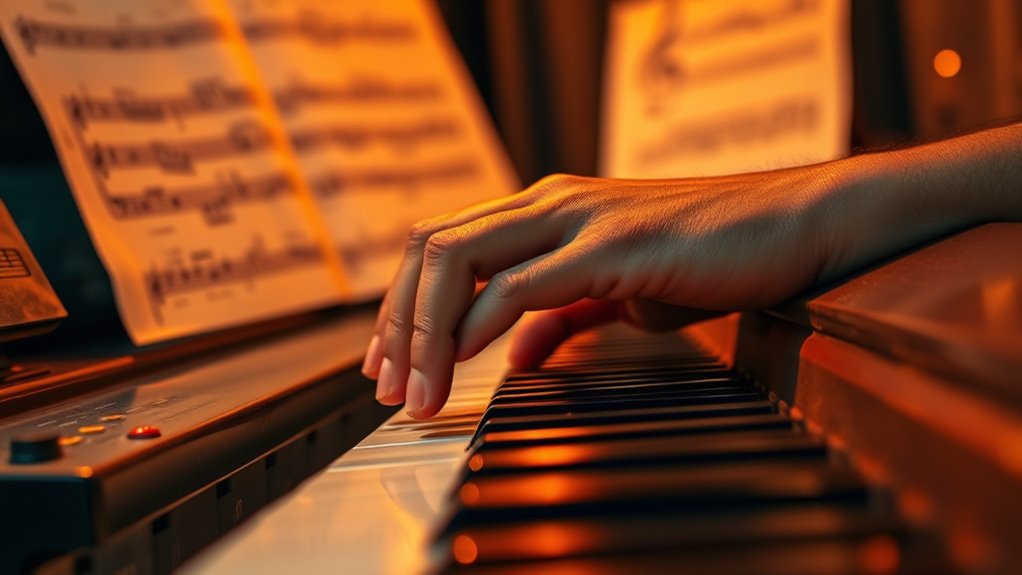
To creatively incorporate modal interchange, start by experimenting with borrowing chords from parallel modes that contrast with your key. For example, if you’re in C major, try borrowing chords from C minor or C Phrygian to add unexpected color. Play around with swapping out standard chords for their modal counterparts—like replacing a major IV with a iv borrowed from the parallel minor. Don’t be afraid to insert a bVII or bVI from a different mode to create tension and surprise. Use these borrowed chords sparingly, focusing on moments that highlight emotional shifts or melodic peaks. Keep listening to how these chords blend or stand out within your progression. With practice, modal interchange becomes a powerful tool to craft progressions that are fresh, memorable, and emotionally compelling.
Avoiding Overuse: Keeping Progressions Engaging
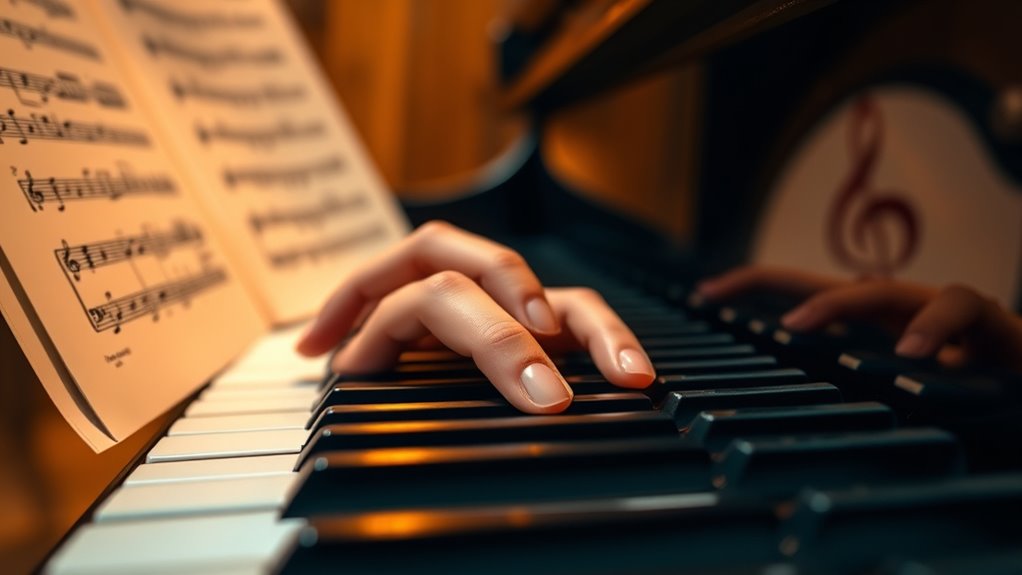
Even when modal interchange adds excitement to your progressions, overusing it can make your music feel cluttered or predictable. To keep your progressions fresh, use modal interchange sparingly—reserve it for key moments that need a boost. Mix in these borrowed chords thoughtfully, so they stand out without overwhelming the entire progression. Avoid constant shifts; instead, create contrast by returning to familiar tonal centers occasionally. Listen critically: if your progression feels predictable or overly busy, cut back on modal interchange. Focus on maintaining a balance between familiar and surprising elements. This way, your listeners stay engaged, enthusiastic for the next twist. Remember, subtlety often makes a bigger impact than constant variation. Keep your progressions engaging by using modal interchange as a spice, not the main ingredient.
Experimenting With Modal Interchange in Your Compositions
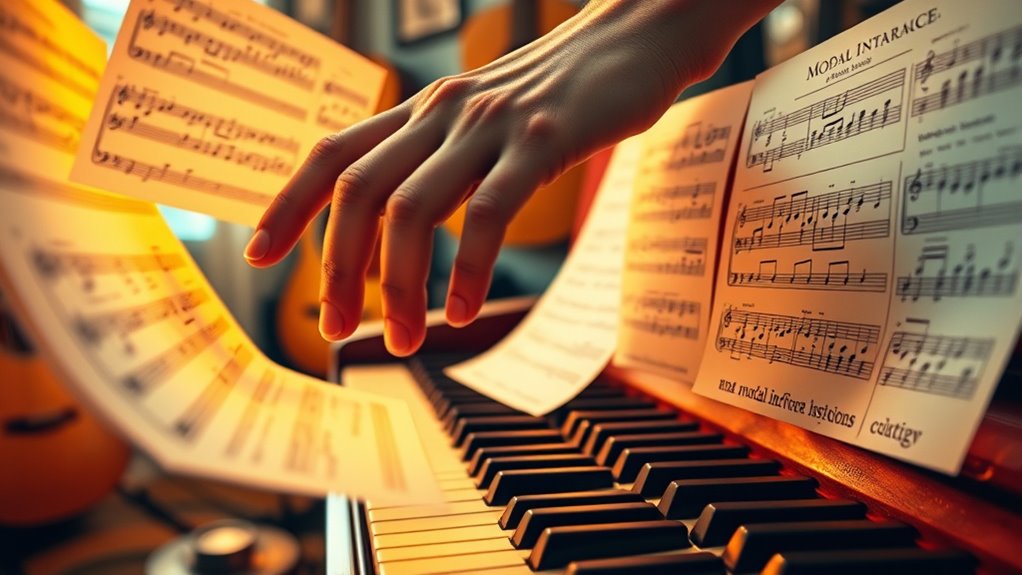
Experimenting with modal interchange opens up exciting creative possibilities in your compositions. It allows you to add unexpected color and emotional depth by borrowing chords from parallel modes. For example, try replacing a standard major chord with its modal interchange counterpart, like switching from a C major to a C minor borrowed from C Phrygian. Play around with borrowing chords from the parallel minor or other modes to create surprising shifts. Use modal interchange sparingly to keep the effect fresh and engaging. Listen closely to how these borrowed chords influence the mood and energy of your progression. Don’t be afraid to experiment freely—sometimes the most memorable moments come from unexpected modal swaps. This approach can turn simple progressions into mesmerizing earworms that stick with your listeners.
Frequently Asked Questions
Can Modal Interchange Be Used in All Musical Genres?
You might wonder if modal interchange can be used in all musical genres. The answer is yes, it’s quite versatile and adaptable. Depending on the style, you can incorporate modal interchange to add color, tension, or surprise. From jazz and pop to classical and folk, this technique enhances progressions and keeps your music engaging. Just remember, the key is to use it thoughtfully to match the mood and genre you’re working in.
How Does Modal Interchange Influence a Song’s Memorability?
You might wonder how modal interchange affects a song’s memorability. When you incorporate chords from different modes, it creates surprising shifts that grab listeners’ attention. These unexpected changes make melodies more interesting and emotionally engaging, helping your song stand out. By adding modal interchange, you increase the chances your audience will remember your tune, as it breaks monotony and sparks curiosity, making your music more memorable and earworm-worthy.
What Are Common Pitfalls When Using Modal Interchange?
When you use modal interchange, watch out for overdoing it, which can make your progression sound disjointed or confusing. It’s easy to stray too far from your original key, causing listener disconnect. Also, avoid using unfamiliar modes without context; they can feel jarring. Instead, aim for subtle shifts that enhance your melody without overpowering the overall harmony, keeping your song engaging and cohesive.
Is Modal Interchange Suitable for Beginner Composers?
Imagine learning to ride a bike; at first, it feels shaky, but with practice, you gain confidence. Modal interchange is similar—great for beginners because it adds color without overcomplicating your progressions. You can experiment with borrowing chords from related modes, creating interesting sounds. It’s a powerful tool to elevate your compositions, making them more engaging while still manageable, especially when you’re just starting out.
How Does Modal Interchange Differ From Other Harmonic Techniques?
Modal interchange differs from other harmonic techniques because it involves borrowing chords from parallel modes or keys, adding surprising color and richness to your progressions. Unlike common techniques like diatonic harmony or secondary dominants, modal interchange creates unexpected shifts that catch the listener’s ear. You actively spice up your compositions by mixing modes, making your progressions more engaging and memorable, and transforming bland sequences into mesmerizing earworms.
Conclusion
So, sparking your songs with stunning, surprising modal interchange can transform tame tunes into tantalizing earworms. By boldly blending borrowed beats and colors, you’ll craft mesmerizing compositions that captivate and charm. Remember, moderation makes magic—mixing and matching with mindful mastery keeps your progressions playful and powerful. With a little experimentation and enthusiasm, you’ll effortlessly elevate every earworm, enchanting audiences and enriching your songwriting journey. Keep creating, and let your melodies mesmerize!
